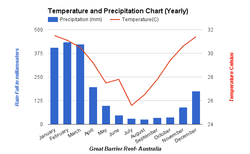Great Barrier Reef Temperature by Month: Best Times to Visit
The Great Barrier Reef, with its enchanting marine biodiversity and breathtaking vistas, stands as one of nature’s most resplendent masterpieces. For avid travelers and marine enthusiasts, understanding the fluctuations in ocean temperatures throughout the year is pivotal. Variations in temperature not only influence the aquatic life but also determine the best times for exploration. Here, we delve into the monthly temperature averages of the Great Barrier Reef and identify the ideal periods for visitation.
Climate nuances and seasonal shifts are paramount in shaping the experience of any visitor. The Great Barrier Reef typically experiences warm tropical weather, but its temperature does possess seasonal variations that warrant consideration.
January to March: The Warm Embrace of Summer
During the height of summer, water temperatures average between 28°C to 30°C (82°F to 86°F). This period marks the peak of the wet season, characterized by occasional thunderstorms and heavy rainfall. While such climatic conditions may seem daunting, they facilitate remarkable insights into the reef’s flora and fauna. The incredibly warm waters attract a plethora of marine life, including vibrant coral spawning events that usually occur in late January. For divers and snorkelers, this is an opportune time to witness the exuberance of underwater ecosystems bursting with life.
However, it is essential to note that while temperatures are inviting, visiting during these months could mean contending with humidity levels around 80-90%. Therefore, those sensitive to sultry climates might want to seek refuge in air-conditioned accommodations after daytime explorations.
April to June: The Transition to Autumn
As summer transitions into autumn, visitors may revel in slightly cooler conditions. Water temperatures usually hover around 25°C to 27°C (77°F to 81°F) in April, gradually moderating towards June. This shoulder season is arguably one of the most pleasant times to visit. The humidity levels decrease considerably, as do the chances of rain, allowing for optimal conditions for both land and marine exploration.
Coral reefs display their breathtaking hues during this period. The visibility for divers expands, making underwater photography opportunities sublime. Moreover, migrating marine species, such as humpback whales, are known to commence their journey during late April, presenting a spectacular opportunity for eco-tourism enthusiasts keen on whale watching.
July to September: The Winter Chill
As Australia’s winter sets in, water temperatures dip to a cooler 22°C to 24°C (72°F to 75°F). July marks the height of the dry season, demonstrating remarkable weather patterns characterized by sunny days and low humidity. Such climatic conditions make for comfortable exploration of both the reef and the mainland. This season is particularly favored by eco-tourists and families because of its milder weather and pleasant temperatures.
Moreover, this period is prime time for diving and snorkeling. The reduced water temperatures provide a refreshing contrast to the warmth on land. Visibility tends to peak, which is a boon for divers hoping to capture the magnificent marine life captured in vivid detail. The pristine conditions foster unforgettable encounters with a diverse array of fish and flourishing coral ecosystems.
October to December: Spring Awakening and Rising Temperatures
As spring blossoms, the water temperatures begin to rise again, reaching around 26°C to 28°C (79°F to 82°F), combined with an uptick in humidity. This transitional period is marked by increasing aquatic activity, as marine creatures prepare for the spawning season. The vibrancy of the reef is magnified as its ecosystem comes alive, welcoming an explosion of color and life.
Visiting during this period offers an unparalleled opportunity to witness the daily rhythms of marine life. Not only can one experience the majesty of the barrier reef firsthand, but the mild, rejuvenating climate makes for delightful excursions.
Ultimately, choosing the best time to visit the Great Barrier Reef hinges on personal preferences regarding climate, marine interactions, and the desire for tranquillity versus a thriving, bustling environment. Each month offers a unique glimpse into the wonders of this natural treasure. Those who are meticulous in planning their visit—taking into account water temperatures and seasonal nuances—will undoubtedly find themselves profoundly enriched by the splendid beauty of the Great Barrier Reef.
You May Also Like
Best Fish to Catch in Australia: A Guide for Anglers
Australia boasts an extraordinary diversity of fish species, making it …
Emily Bay Norfolk Island: A Hidden Gem in the Pacific
Emily Bay, a picturesque enclave nestled on the sun-kissed shores of …
Holidays on August 23: Global Festivities & Observances
August 23 is a date that carries a bouquet of cultural significance …





